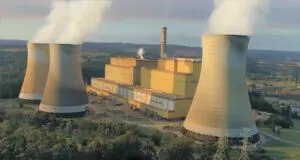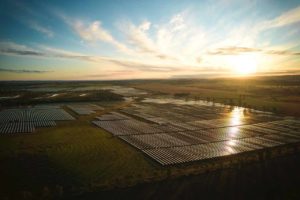A short briefing on renewables deployment hit the decks today, and it was reported as if it showed that Australia will meet the existing emissions target well before 2030.
The federal energy minister Angus Taylor trumpeted this as justification for the government’s do-nothing approach. But it won’t be that way unless there is policy support, as serious analyses have shown.
Renewables were deployed quickly and at scale in Australia in recent times, especially during 2018. A huge wind and solar boom is on, and it’s important to recognize that. But it is not a given that it will continue at this rate, and indefinitely.
What our ANU colleagues Andrew Blakers, Matt Stocks and Bin Lu illustrated is what would happen if that speed of deployment continued at the same rate in future years: about 6GW of new wind and solar per year.
As they point out, this would mean 50% renewables by the mid-2020s, and 100% renewables by about 2030, depending on electricity demand trajectories. With some assumptions about the displacement of fossil fuel based power and about what happens in the rest of the economy, they calculate that the 26-28% reduction target would be met in 2025.
But it is a very big assumption that renewables deployment would continue at present rates. And all it is is a straight-line extrapolation from one year’s renewables deployment.
# The big ifs for future renewables deployment
The recent boom has been driven by a shortage in supply capacity after coal plant closures, reflected in abnormally high wholesale prices; and also by state government contract schemes. Wholesale prices are likely to moderate as more renewables capacity comes online.
From then on, it is a question of the relative costs of running existing coal plants versus the cost of new renewables plants. Some coal plants are already at the verge of being unprofitable given currently high coal prices.
As renewables become cheaper, this trend will continue, pushing coal plants out of the market and thereby creating space for extra renewables in the system.
Coal exit may happen more quickly than assumed in some recent reports. But how quickly depends on many factors. That deserves analysis, not straight-line extrapolation.
The pace of renewables expansion also depends on whether and when new renewables can be connected to the grid. And as the share of renewables rises, more energy storage is needed to soak up excess power production and kick in when renewables and remaining fossil fuel plants cannot.
# The to-do list
So in order to see continued fast renewables deployment, there will need to be the right policy environment, so that investors do not once again get the jitters.
Some form of price signal on carbon would do the job nicely, ideally in line with a carbon price signal in other parts of the economy, and perhaps in line with international carbon markets. Contracts or contracts-for-difference underwritten by governments are an effective option also.
And there needs to be massive investment in transmission, to get all these new solar farms and wind parks on the grid. It is not clear that the existing regulatory structures will be able to effectively and efficiently provide this. Similarly for energy storage, it is not clear whether this will be provided rapidly and at scale under the existing market settings.
Things are not straightforward for exit by coal power plants either. Plant closures are painful, tempting governments to support continued operation for individual plants to postpone the job losses.
And some plant operators may choose to keep plants running even when they don’t make much money, for example in order to postpone site remediation costs. So, a framework or policy mechanism will be needed to facilitate the orderly closure of all these coal plants.
Finally, there’s the not-so-small matter of the rest of the economy. Two thirds of Australia’s national emissions come from sources other than electricity, and they have been rising. Effective measures are needed right through the economy to get to deeper emissions reductions, and to do so cost-effectively.
# Emissions
Australia’s national emissions, as per the government’s most recent projections document, were 534 Mt CO2 equivalent in 2018, and 605 Mt in 2005. A 27% reduction relative to 2005 means 442 Mt, that is 92 Mt lower than now.
Blakers et al assume a reduction in emissions of 2 Mt per year for every additional GW of renewables capacity. So if there is an addition 6 GW per year, that’s 12 Mt per year saved, and assuming then (as Blakers et al do) that emissions in all other sectors rise only slowly, that would hit the target in the mid-2020s.
But Australia’s current total electricity sector emissions are 182 Mt per year. So this would equate to cutting power sector emissions by more than half, or roughly halving coal fired power output.
Half of the existing coal fired power fleet shut by 2025, or all of it running at half output? It would be possible, and desirable from the perspective of emissions savings. But it probably won’t happen by 2025 without a host of support policies, large network investments, and measures to deal with the social and political pain of to coal plant closures.
2030 is a much more realistic timeframe for such changes. By then it will also be possible to significantly reduce emissions from the other parts of the economy (the two thirds of emissions). That includes electrification in transport, industry and housing, replacing gas, petrol, diesel and coal with renewable electricity. And it includes greater energy efficiency, and better processes in mining, chemical industries and agriculture.
And if renewables keep coming on strongly, then that is a potent reason for taking on a stronger emissions target. That in turn will make it possible to achieve a much stronger reduction than the 26-28% at 2030. And crucially it can set the country on a trajectory towards truly deep emissions reductions.
But it won’t happen all by itself.
Frank Jotzo is a professor at the ANU Crawford School of Public Policy, where he leads the Centre for Climate and Energy Policy.








